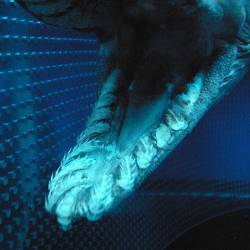The Frilled Shark Family
Chlamydoselachidae
Now, if you are going by the name frilled shark and expecting a pretty little lacy character you might not want to look at the video below. This chappie is not pretty. Having said that I do have a hard time calling him ugly.
Actually, the one in the video is a her and, I must say, as odd looking as she is, she does have some sort of charm.
Sadly, the shark in the video died only hours after the video was shot. Once thought to be extinct this specimen was spotted by a fisherman in shallow water off the coast of Japan in January 2007.
The shark was taken to Awashima Marine Park where this footage was taken. It's thought she was sick at the time of the capture and that may have been why she was in the shallows. They normally live at depths of up to 1500m.
This family contains one genus and two known species.
Frilled Shark Characteristics
- General body shape - These sharks have long slender bodies and are almost snake-like in appearance. They have a flattened head and a very short snout. The lateral line in these sharks is an open groove down each side, rather than the jelly-filled tube situated below the skin as it is in other sharks. Some people believe that it was these sharks, or a larger relative, that gave rise to the rumours of giant sea serpents.
- Personally, I like to think that giant sea serpents (and the Loch Ness Monster) really exist, but then I am a
- Eyes - The eyes are oval and fairly large. They have no nictitating membranes.
- Teeth - Their teeth have three cusps and are spaced wide apart. They are very sharp and, I have to say, scary looking.
- Gills - The frilly looking gills are what give this shark its name. Like the cow sharks, they have six pairs of gills. Unlike the cow sharks, however, the first gill slits connect underneath the throat.
- Fins - They have a single low dorsal fin which is set well back on the body. The paired pectoral fins sit well forward and are smaller than the pelvic fins.
There is an anal fin present and it is much larger than the dorsal fin. The caudal fin is long and triangular with no lower lobe.
These sharks are ovoviviparous. They are very primitive and are sometimes called living fossils. The two species are very difficult to tell apart going on external appearance alone but they do have marked differences internally.
Return to World of Sharks from Chlamydoselachidae
General Body Shape

Teeth
Recent Articles
-
Thresher Sharks
Aug 27, 14 10:51 AM
Thresher sharks are unmistakable with that huge upper lobe on the caudal fin. Let's find out more about them. -
Sharkwater
Aug 14, 14 12:42 PM
Sharkwater is a documentary by Rob Stewart highlighting the plight of the sharks in our oceans. -
Natural Cleaners
Aug 13, 14 08:57 AM
Natural cleaners and homemade skincare products are not only better for the environment, they're better for you and your family.
